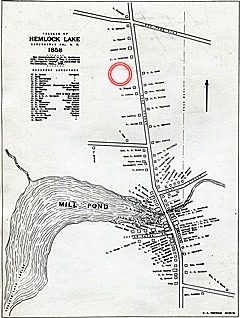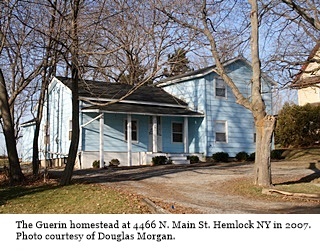
Welcome to Hemlock and Canadice Lakes!
Barns Businesses Cemeteries Churches Clinton & Sullivan Columns Communities Documents Events Time Line Fairs & Festivals Farm & Garden Hiking Homesteads Lake Cottages Lake Scenes Landscapes Library News Articles Old Maps Old Roads & Bridges Organizations People Photo Gallery Podcasts Railroad Reservoir Schools State Forest Veterans Videos
|
The Guerin Family Homestead at 4466 N. Main St. Hemlock NY |
Click any image to enlarge. |
|
The Three Guerin Houses of Hemlock NY
A Historical review by Joy Lewis, the Richmond NY Historian.
1 Click image to enlarge. The three-acre piece of meadow on the west side of Route 15A changed hands several times before 1870 when Silas Thurston sold it to Charles Guerin. The Guerin family came to Livonia early in the 1850s from Seneca County, settling east of Livonia Center before relocating to Main Street in Hemlock around 1867. Jared Guerin, his two brothers William and Oscar, and his sons Charles and George, were blacksmiths and wagon makers. The rectangular piece of land was divided into four equal lots of ¾ acre each. The northernmost portion (4485) was the site of the forge. This parcel did not have a dwelling until about 1928. On the other three lots owned by the Guerins were built in 1872 three modest houses. These houses are quite similar to one another: each features a gable-front on the north side, with a wing on the south. Over the course of many decades cosmetic changes have been made to the exterior of each house, but the basic structure may still be discerned.
|
||
|
The Guerin House at 4466 N. Main Street Hemlock NY 2 The Guerin Homestead at 4466 N. Main St. in Hemlock NY. Photo courtesy of Douglas Morgan in 2007. This house was built for George Guerin and his wife Eunice. They were both in their mid-thirties and had a twelve-year-old son, Charles. Toward the close of the 1870s, the Guerin brothers relocated their black smith shop to a property further south on Main Street (on the east side of the road, just south of Clay Street). George and Charles both moved as well to be nearer the forge. Imogene Wilkinson, a young widow-woman with two small daughters, bought George’s house in 1878. She sold up rather quickly, moving away from Hemlock three years later. In the space of a few short months the house was sold twice - first to Jeanette Jenks, who simply “flipped” it and resold it to Martha Holmes, who rented the house to various tenants. Martha (Maxey) Holmes was in her mid-forties in 1855 when she and her family came from England and settled on a farm in Conesus. She and her husband William Holmes were the parents of eight children, ranging in age from twenty to three: Charles, Robert, William, Betsey, Martha, Sarah, John, and Jane. In the winter of 1880 seventy-two-year old William Holmes was killed while in the woods cutting firewood; a tree fell on him. Martha bought the “Guerin place” (as it was then known) as income property. When she died five years later her executors sold the house to William Gilboy. William was forty-five at the time, a widower with three daughters and a son — Anna, Mary, Charlotte, and William. He was a Civil War veteran, having served three years with the New York 1st Dragoons. At the close of the war he returned to Leicester where he married. The Gilboy family settled in Nunda. An experienced farm hand, William moved to Livonia after the death of his wife Flora in 1879. Then he bought the house in Hemlock and moved again. Only a few years passed before William sold the house. He went to live with his son in Rochester, and later lived with a daughter in Batavia, where he died in the autumn of 1919. Both he and Flora are buried in the Greenmount Cemetery in Dansville. The next owners of the house, when it was sold in 1892, were Martha Holmes’ son William and his son Russell. As these men lived in Pennsylvania, it is certain that their purpose was to use the house as income property. For fifteen years the house was let to a variety of tenants: farm laborers and railroad workers, families who came and went year to year. In 1907 John Coykendall, a skilled carpenter, bought the house and lived there with his family for four years. A young man of thirty-four, John was married to Agnes Varney. Their son Ken was eight. While they lived in Hemlock, another son was born: Lee in 1909. When they sold this house, they bought another further south along Hemlock’s Main Street. Nora (Boyle) Meager bought the house in 1911. One of seven children born to Irish parents Michael and Hannah Boyle, Nora was five years old in 1856 when her family came to the United States from Canada and settled on a farm in Lima. Through the early years of her adulthood, Nora made her living as a dressmaker. At age thirty-one she married John Meagher of Livonia. They had a thriving farm on the outskirts of Hemlock. (The house they lived in, on the southwest corner of Clay Street and Big Tree Road, is no longer standing.) On August 3, 1893 John was appointed Postmaster of Hemlock Lake. The name of the post office was changed to “Holden” on September 7, 1895 and changed again two months later to “Hemlock.” John died in September 1896; on the 22nd of that month Nora was appointed Postmaster in her husband’s place. She served for the next year and a half. Nora’s daughter Frances was a young teen when her father died. Nora took a job as a housekeeper for a distant cousin, David Cavanaugh, in Richmond. Then in 1911, when she was nearing sixty, she bought the house in Hemlock for herself and her daughter. Both of them worked as laundresses for some years. In 1922 Frances married Patrick Maher, an itinerant odd-job man, and he moved into the home. Nora’s younger sister Johanna Boyle also lived with the family. In the early autumn of 1929 Johanna died of pneumonia. Three weeks later Nora died in the same house of the same disease, after only a day’s illness. John and Nora Meagher and Johanna Boyle are all buried at St. Rose Cemetery in Lima. Frances and Patrick, who were childless, lived in the house for many more years. He died about 1942 and Frances continued to live alone in the house until her death in 1977. The house, which had reverted at some time to the Livingston County Commissioner of Public Welfare, was then sold to Jim and Linda Parrish.
|
||
|
On A Personal Note Our family lived in a house just down the hill from Mrs. Maher. She was a particular friend of my siblings and me. I remember her as a rather small woman. She always wore a long skirt, black, or gray, or soft-brown, with a matching bodice trimmed with lace or beads. She kept her silver-colored hair in a tidy bun inside a hairnet and spoke with a smile in her voice. Every year on May Day my sister Wendy, brothers Rob and Larry, and I made a May Basket for her. It was quite a simple arrangement, made from a square of colored construction paper twisted into a cone and held together with copious amounts of Elmer’s glue. It was then filled with a dainty bouquet of the jonquils that grew wild behind our house and a ribbon handle was tied on. We took this offering to Mrs. Maher’s front door, looped the ribbon over her doorknob, knocked loudly, and scampered away. There was a hedge between her house and the one next door to the north. We hid behind the hedge and watched from there as she retrieved the flowers. Once she closed the door, we hightailed it for home. Within the hour Mom would get a phone call and we’d be invited to Mrs. Maher’s house so she could thank us. Visits to her house were not limited to May Day, however. Quite a few times through the year Mom would take us to visit, always bringing some small gift to our friend. On every visit Mrs. Maher treated us to homemade cookies in her sitting room. Just inside the front door was a little “foy-yay” — as we at that time were taught to say. (One teacher told us, “Only ignorant people say ‘foy-er’.”) To the left of the foyer was the little room where we enjoyed our visit. A dainty sofa, whose arms and back were edged with mahogany and upholstered in a faded maroon, was positioned with its back to the front window. This was clothed in a pair of heavy lace curtains, neveropened. On the floor was a red-and-black patterned rug. Completing the furnishings were a tall, round stand holding a profligate fern, a sparsely-filled bookcase, a small heating stove, and a couple of rocking chairs. For many years my siblings and I visited Mrs. Maher every May Day. When we older kids outgrew May Basket making, my younger siblings Katy, Shelly, and Kip continued the tradition. It was a sad day when we learned of her death.
|
||

